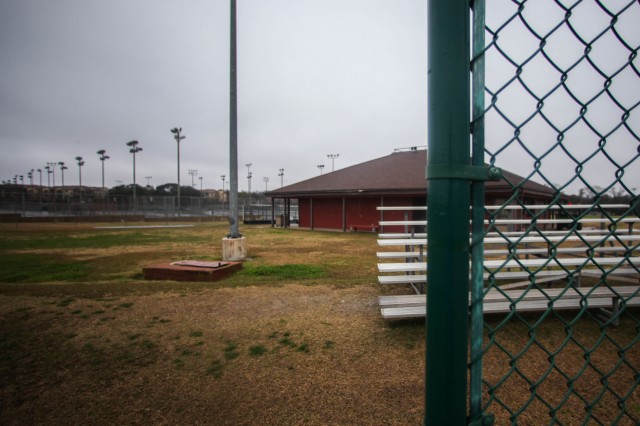UT Intramural Fields Await Overhaul

UT RecSports hopes to raise enough money to renovate the 35-acre Whitaker Fields, which serves as a practice and game area for intramural competitions. Photo by Skyler Wendler/Reporting Texas
By Corey Schneider
For Reporting Texas
Veronica Martinez entered college with little idea of her future but sure of her past: sports. Her passion for athletic competition provided stability amid the confusion of the University of Texas.
“The rules were the same, it was just new competition, new friends to be made along with new rivals on the field,” said Martinez, 21, a UT intramural program assistant and senior exercise science major from Austin. Whitaker Fields “felt like home when everything else made me feel lost.”
Whitaker Fields is a 35-acre space that holds 18 football and soccer fields and an archery range. Located at the southeast corner of 51st and Guadalupe streets, the complex, built in 1980, serves as a practice and game area for most of UT’s intramural competitions and sports clubs.
A 2006 engineering study concluded that the facility had exhausted 98 percent of potential safe usage, according to Jennifer Speer, UT RecSports associate director. Speer said the fields are ready for extensive repairs.
Renovations will improve the outdated irrigation, sod and inefficient lighting systems, among other enhancements, if the RecSports program can raise the money. That’s a big if: RecSports has been raising money since 2011, and it’s only 70 percent of the way toward its $20 million goal. Speer said the department is determined to find a way to pay for the work.
“Intramurals is the heart of this program,” Speer said. “Having the facility to support that is a must for us.”
RecSports uses a list of “comparative institutions” to ensure that its facilities and programs are up to par with similar schools around the nation, such as Ohio State University, the University of Nebraska, and the University of North Carolina. Texas A&M University, which is also on the list, recently completed the Penberthy Rec Sports Complex, which Speer says is now one of the best in the country. Speer also noted that when it opened in 1980, Whitaker — named after Berry M. Whitaker, the original director of the UT intramural program — was the premier recreational complex in the nation and the only lighted intramural field in the country.
In 2011, RecSports began fundraising and planning for the field’s renovation. Contractors estimate the 12- to 15-month project will cost $10 million in infrastructure improvements and another $10 million for additional enhancements, including a modernized fencing and security system, a central hut, restrooms and synthetic turf fields.
RecSports originally planned to begin the project in May and complete it in summer 2016, the centennial of the program’s inception. But a lack of sufficient funds has indefinitely postponed the project. The challenge of raising the remaining $6 million is exacerbated by the fact that the program relies entirely on student fees, with no financial support from the university.
As the fundraising slowly nears its goal, clubs and teams that use the facilities look elsewhere for training and competitions.
UT’s men’s ultimate Frisbee team started exploring other practice and game locations as soon as RecSports announced the project. Despite the challenge of finding ample space near campus, club president Alex Stolzberg’s biggest concern is money. The team now practices at Whitaker three times a week in addition to hosting competitions, and reserving fields for practices and tournaments will create expenses the team simply can’t afford.
Stolzberg, 22, a senior computer engineering major from Houston, also said that because there is little open grass space near the UT campus, a new location would likely inconvenience or deter potential team members.
“We recruit a lot of new players in the fall, and if we weren’t able to host our tryouts at Whitaker, people may not show up at all,” Stolzberg said. “A low recruiting class could affect our team’s strength in future years.”
The project’s potential negative effects extend beyond sports clubs, said Mia Fredricks, 20, a junior public relations student from Houston. Fredricks, a frequent intramural participant who “ventured to intramurals in order to keep [her] competitive and athletic spirit alive,” said the renovation could damage intramural participation beyond the completion of the project.
If RecSports implements the project, Fredricks said, it will be “losing the loyalty and faith of customers at UT for a while.”
Martinez said the project will displace staff and participants from the core location of their work and play.
“It would require a new outlook on progressing the program in a positive way in order to get through the rough patch of not being in our proper home of Whitaker Fields,” Martinez said.
Speer said she might not have answers now to all the pressing questions, but she has confidence in her team.
“We have a need, we have a great design, we have students that love this program and appreciate it and want to make sure it continues,” Speer said. “You have to have a little faith that all of this will come together long term.”